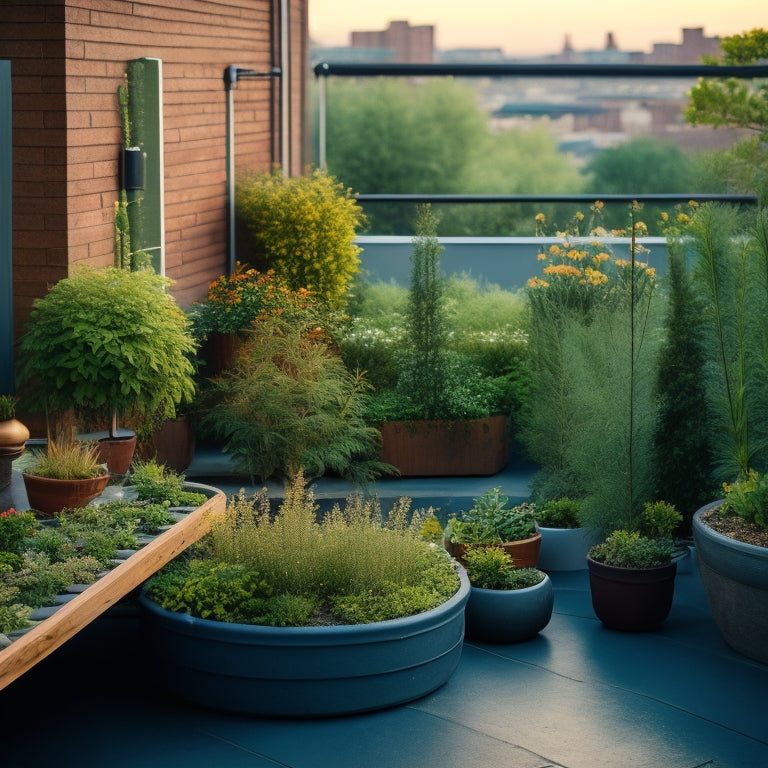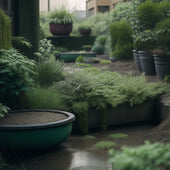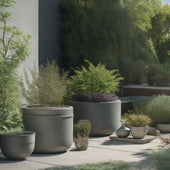
3 Best Rainwater Irrigation Methods for Rooftop Herbs
Share
When you're cultivating rooftop herbs, harvesting rainwater is a smart move. You'll conserve water and reduce your dependence on city supplies. Three effective rainwater irrigation techniques for rooftop herbs are direct rainwater drip irrigation, which delivers water precisely to roots; roof-collection gravity feed systems, which utilize gravity to distribute water without pumps; and tank-based sprinkler irrigation methods, which offer flexibility and automation. Each method has its benefits, and by implementing one, you'll be taking a step towards sustainable gardening. Now, delve into these methods in more detail to reveal their full potential for your rooftop herb garden.
Key Takeaways
• Direct rainwater drip irrigation delivers water precisely to roots, minimizing evaporation and runoff for healthier herb plants.
• Roof-collection gravity feed systems utilize natural gravity force for irrigation, enhancing water quality and conserving water.
• Tank-based sprinkler irrigation methods offer flexibility and automation, promoting consistent moisture levels for rooftop herb gardens.
• Implementing rainwater irrigation techniques reduces reliance on municipal water supplies, contributing to sustainable gardening practices.
• Rainwater harvesting is essential for efficient water use, making it a crucial step in rooftop herb garden irrigation.
Direct Rainwater Drip Irrigation
By installing a direct rainwater drip irrigation system, you can deliver water directly to the roots of your rooftop herbs, minimizing evaporation and runoff. This efficient system guarantees your herbs receive exactly the right amount of water, precisely when they need it. As a result, you'll enjoy healthier, more vibrant plants that thrive in their rooftop environment.
Rainwater harvesting is an essential component of this system, as it allows you to collect and store precious water for later use. By harnessing the power of rainwater, you'll reduce your reliance on municipal water supplies and lower your water bill.
In terms of herb garden maintenance, a direct rainwater drip irrigation system makes it easy to keep your plants happy and healthy. With water delivered directly to the roots, you'll reduce the risk of overwatering, which can lead to root rot and other diseases. Plus, with reduced evaporation and runoff, you'll minimize the risk of water-borne pests and diseases.
Roof-Collection Gravity Feed Systems
By setting up a roof-collection gravity feed system, you'll utilize the natural force of gravity to distribute rainwater from your rooftop to your herb garden, eliminating the need for pumps and decreasing energy consumption. This efficient system allows you to gather and utilize rainwater without depending on external power sources, providing you the flexibility to irrigate your herbs as nature intended.
Here are three benefits that will get you excited about roof-collection gravity feed systems:
-
Minimized water waste:
With a gravity feed system, you can direct rainwater precisely where it's needed, reducing runoff and evaporation. -
Enhanced water quality:
By incorporating filtration systems, you can guarantee that your herbs receive clean, chemical-free water, supporting healthy growth and flavor. -
Improved water conservation:
Tank-Based Sprinkler Irrigation Methods
You can efficiently irrigate your rooftop herb garden using tank-based sprinkler irrigation methods. This involves storing collected rainwater in a tank and distributing it through a network of pipes and sprinklers. The system provides flexibility and control, allowing you to water your herbs precisely when they need it.
To automate the process, consider installing solar-powered timers that can be programmed to water your herbs at specific intervals. This ensures consistent moisture levels and promotes the best growth.
Tank-based sprinkler irrigation methods are also an effective way to conserve water. They allow you to harvest and store rainwater for later use, reducing reliance on municipal water supplies. This approach minimizes wastewater runoff, making it an environmentally friendly option.
By using a tank-based system, you can collect and store rainwater during periods of abundance. Then, you can use it to irrigate your herbs during dry spells, reducing overall water consumption.
With careful planning and implementation, tank-based sprinkler irrigation methods can help you create a thriving rooftop herb garden. This method promotes water conservation and sustainability.
Frequently Asked Questions
How Often Should I Clean My Rainwater Collection System?
'Did you know that 1 in 5 rooftop rainwater harvesting systems are contaminated with debris? You should clean your system every 2-3 months to prevent contamination, ensuring best water quality and healthy herb growth.'
Can I Use Rainwater for Herbs With High Water Requirements?
You'll need to assess herb watering frequency and rainwater quality before using it for herbs with high water requirements; verify your collected rainwater is free from contaminants and suitable for your herbs' specific needs.
Are There Any Specific Roof Materials Suitable for Rainwater Harvesting?
'You're literally sitting on a goldmine - your roof! Make sure it's made of compatible materials like asphalt shingles, metal, or concrete tiles, and you'll be harvesting rainwater for sustainable gardening in no time, free from the grid!'
Do I Need to Treat Rainwater Before Using It for Irrigation?
You'll want to treat rainwater before irrigation to guarantee safety, as it may contain chemical contaminants from your roof. Implementing a filtration system can alleviate concerns, providing clean water for your crops to thrive.
Can I Combine Rainwater Irrigation With Traditional Watering Methods?
As you harmonize rainwater irrigation with traditional methods, you're marrying freedom with flexibility, ensuring soil moisture levels are balanced and efficiency of watering is optimized, perfect for urban gardening's pursuit of sustainable practices.
Related Posts
-

Why Urban Gardens Need Better Planter Drainage Systems
When you neglect to install a well-designed drainage system in your urban garden, you're fundamentally sentencing you...
-

Why Urban Gardens Need Better Planter Drainage Systems
When you neglect to install a well-designed drainage system in your urban garden, you're fundamentally sentencing you...
-

Why Urban Gardens Need Better Planter Drainage Systems
When you neglect to install a well-designed drainage system in your urban garden, you're fundamentally sentencing you...
-

Why Urban Gardens Need Better Planter Drainage Systems
When you neglect to install a well-designed drainage system in your urban garden, you're fundamentally sentencing you...
-

Why Urban Gardens Need Better Planter Drainage Systems
When you neglect to install a well-designed drainage system in your urban garden, you're fundamentally sentencing you...
-

Why Urban Gardens Need Better Planter Drainage Systems
When you neglect to install a well-designed drainage system in your urban garden, you're fundamentally sentencing you...
-

Why Urban Gardens Need Better Planter Drainage Systems
When you neglect to install a well-designed drainage system in your urban garden, you're fundamentally sentencing you...
-

Why Urban Gardens Need Better Planter Drainage Systems
When you neglect to install a well-designed drainage system in your urban garden, you're fundamentally sentencing you...
-

Why Urban Gardens Need Better Planter Drainage Systems
When you neglect to install a well-designed drainage system in your urban garden, you're fundamentally sentencing you...
-

Why Urban Gardens Need Better Planter Drainage Systems
When you neglect to install a well-designed drainage system in your urban garden, you're fundamentally sentencing you...
-

Why Urban Gardens Need Better Planter Drainage Systems
When you neglect to install a well-designed drainage system in your urban garden, you're fundamentally sentencing you...
-

Why Urban Gardens Need Better Planter Drainage Systems
When you neglect to install a well-designed drainage system in your urban garden, you're fundamentally sentencing you...
-

Why Urban Gardens Need Better Planter Drainage Systems
When you neglect to install a well-designed drainage system in your urban garden, you're fundamentally sentencing you...
-

Why Urban Gardens Need Better Planter Drainage Systems
When you neglect to install a well-designed drainage system in your urban garden, you're fundamentally sentencing you...
-

Why Urban Gardens Need Better Planter Drainage Systems
When you neglect to install a well-designed drainage system in your urban garden, you're fundamentally sentencing you...
-

Why Urban Gardens Need Better Planter Drainage Systems
When you neglect to install a well-designed drainage system in your urban garden, you're fundamentally sentencing you...
-

Why Urban Gardens Need Better Planter Drainage Systems
When you neglect to install a well-designed drainage system in your urban garden, you're fundamentally sentencing you...
-

Why Urban Gardens Need Better Planter Drainage Systems
When you neglect to install a well-designed drainage system in your urban garden, you're fundamentally sentencing you...
-

Why Urban Gardens Need Better Planter Drainage Systems
When you neglect to install a well-designed drainage system in your urban garden, you're fundamentally sentencing you...
-

Why Urban Gardens Need Better Planter Drainage Systems
When you neglect to install a well-designed drainage system in your urban garden, you're fundamentally sentencing you...
-

Why Urban Gardens Need Better Planter Drainage Systems
When you neglect to install a well-designed drainage system in your urban garden, you're fundamentally sentencing you...
-

Why Urban Gardens Need Better Planter Drainage Systems
When you neglect to install a well-designed drainage system in your urban garden, you're fundamentally sentencing you...
-

Why Urban Gardens Need Better Planter Drainage Systems
When you neglect to install a well-designed drainage system in your urban garden, you're fundamentally sentencing you...
-

Why Urban Gardens Need Better Planter Drainage Systems
When you neglect to install a well-designed drainage system in your urban garden, you're fundamentally sentencing you...
-

Why Urban Gardens Need Better Planter Drainage Systems
When you neglect to install a well-designed drainage system in your urban garden, you're fundamentally sentencing you...
-

Why Urban Gardens Need Better Planter Drainage Systems
When you neglect to install a well-designed drainage system in your urban garden, you're fundamentally sentencing you...
-

Why Urban Gardens Need Better Planter Drainage Systems
When you neglect to install a well-designed drainage system in your urban garden, you're fundamentally sentencing you...
-

Why Urban Gardens Need Better Planter Drainage Systems
When you neglect to install a well-designed drainage system in your urban garden, you're fundamentally sentencing you...
-

10 Tips for Training Vines in a Vertical Garden
When training vines in a vertical garden, you'll want to choose the right species for your climate, prepare your wall...
-

10 Tips for Training Vines in a Vertical Garden
When training vines in a vertical garden, you'll want to choose the right species for your climate, prepare your wall...
-

10 Tips for Training Vines in a Vertical Garden
When training vines in a vertical garden, you'll want to choose the right species for your climate, prepare your wall...
-

10 Tips for Training Vines in a Vertical Garden
When training vines in a vertical garden, you'll want to choose the right species for your climate, prepare your wall...
-

10 Tips for Training Vines in a Vertical Garden
When training vines in a vertical garden, you'll want to choose the right species for your climate, prepare your wall...
-

10 Tips for Training Vines in a Vertical Garden
When training vines in a vertical garden, you'll want to choose the right species for your climate, prepare your wall...
-

10 Tips for Training Vines in a Vertical Garden
When training vines in a vertical garden, you'll want to choose the right species for your climate, prepare your wall...
-

10 Tips for Training Vines in a Vertical Garden
When training vines in a vertical garden, you'll want to choose the right species for your climate, prepare your wall...
-

10 Tips for Training Vines in a Vertical Garden
When training vines in a vertical garden, you'll want to choose the right species for your climate, prepare your wall...
-

10 Tips for Training Vines in a Vertical Garden
When training vines in a vertical garden, you'll want to choose the right species for your climate, prepare your wall...
-

10 Tips for Training Vines in a Vertical Garden
When training vines in a vertical garden, you'll want to choose the right species for your climate, prepare your wall...
-

10 Tips for Training Vines in a Vertical Garden
When training vines in a vertical garden, you'll want to choose the right species for your climate, prepare your wall...
-

10 Tips for Training Vines in a Vertical Garden
When training vines in a vertical garden, you'll want to choose the right species for your climate, prepare your wall...
-

10 Tips for Training Vines in a Vertical Garden
When training vines in a vertical garden, you'll want to choose the right species for your climate, prepare your wall...
-

10 Tips for Training Vines in a Vertical Garden
When training vines in a vertical garden, you'll want to choose the right species for your climate, prepare your wall...
-

10 Tips for Training Vines in a Vertical Garden
When training vines in a vertical garden, you'll want to choose the right species for your climate, prepare your wall...
-

10 Tips for Training Vines in a Vertical Garden
When training vines in a vertical garden, you'll want to choose the right species for your climate, prepare your wall...
-

10 Tips for Training Vines in a Vertical Garden
When training vines in a vertical garden, you'll want to choose the right species for your climate, prepare your wall...
-

10 Tips for Training Vines in a Vertical Garden
When training vines in a vertical garden, you'll want to choose the right species for your climate, prepare your wall...
-

10 Tips for Training Vines in a Vertical Garden
When training vines in a vertical garden, you'll want to choose the right species for your climate, prepare your wall...
-

10 Tips for Training Vines in a Vertical Garden
When training vines in a vertical garden, you'll want to choose the right species for your climate, prepare your wall...
-

10 Tips for Training Vines in a Vertical Garden
When training vines in a vertical garden, you'll want to choose the right species for your climate, prepare your wall...
-

10 Tips for Training Vines in a Vertical Garden
When training vines in a vertical garden, you'll want to choose the right species for your climate, prepare your wall...
-

10 Tips for Training Vines in a Vertical Garden
When training vines in a vertical garden, you'll want to choose the right species for your climate, prepare your wall...
-

10 Tips for Training Vines in a Vertical Garden
When training vines in a vertical garden, you'll want to choose the right species for your climate, prepare your wall...
-

10 Tips for Training Vines in a Vertical Garden
When training vines in a vertical garden, you'll want to choose the right species for your climate, prepare your wall...
-

10 Tips for Training Vines in a Vertical Garden
When training vines in a vertical garden, you'll want to choose the right species for your climate, prepare your wall...
-

10 Tips for Training Vines in a Vertical Garden
When training vines in a vertical garden, you'll want to choose the right species for your climate, prepare your wall...
-

10 Tips for Training Vines in a Vertical Garden
When training vines in a vertical garden, you'll want to choose the right species for your climate, prepare your wall...
-

10 Tips for Training Vines in a Vertical Garden
When training vines in a vertical garden, you'll want to choose the right species for your climate, prepare your wall...
-

10 Tips for Training Vines in a Vertical Garden
When training vines in a vertical garden, you'll want to choose the right species for your climate, prepare your wall...
-

10 Tips for Training Vines in a Vertical Garden
When training vines in a vertical garden, you'll want to choose the right species for your climate, prepare your wall...
-

Summer Care Tips for Concrete Planters
As you step into the warmest season of the year, your concrete planters require deliberate care to thrive. Clean your...
-

Summer Care Tips for Concrete Planters
As you step into the warmest season of the year, your concrete planters require deliberate care to thrive. Clean your...
-

Summer Care Tips for Concrete Planters
As you step into the warmest season of the year, your concrete planters require deliberate care to thrive. Clean your...
-

Summer Care Tips for Concrete Planters
As you step into the warmest season of the year, your concrete planters require deliberate care to thrive. Clean your...
-

Summer Care Tips for Concrete Planters
As you step into the warmest season of the year, your concrete planters require deliberate care to thrive. Clean your...
-

Summer Care Tips for Concrete Planters
As you step into the warmest season of the year, your concrete planters require deliberate care to thrive. Clean your...
-

Summer Care Tips for Concrete Planters
As you step into the warmest season of the year, your concrete planters require deliberate care to thrive. Clean your...
-

Summer Care Tips for Concrete Planters
As you step into the warmest season of the year, your concrete planters require deliberate care to thrive. Clean your...
-

Summer Care Tips for Concrete Planters
As you step into the warmest season of the year, your concrete planters require deliberate care to thrive. Clean your...
-

Summer Care Tips for Concrete Planters
As you step into the warmest season of the year, your concrete planters require deliberate care to thrive. Clean your...
-

Summer Care Tips for Concrete Planters
As you step into the warmest season of the year, your concrete planters require deliberate care to thrive. Clean your...
-

Summer Care Tips for Concrete Planters
As you step into the warmest season of the year, your concrete planters require deliberate care to thrive. Clean your...
-

Summer Care Tips for Concrete Planters
As you step into the warmest season of the year, your concrete planters require deliberate care to thrive. Clean your...
-

Summer Care Tips for Concrete Planters
As you step into the warmest season of the year, your concrete planters require deliberate care to thrive. Clean your...
-

Summer Care Tips for Concrete Planters
As you step into the warmest season of the year, your concrete planters require deliberate care to thrive. Clean your...
-

Summer Care Tips for Concrete Planters
As you step into the warmest season of the year, your concrete planters require deliberate care to thrive. Clean your...
-

Summer Care Tips for Concrete Planters
As you step into the warmest season of the year, your concrete planters require deliberate care to thrive. Clean your...
-

Summer Care Tips for Concrete Planters
As you step into the warmest season of the year, your concrete planters require deliberate care to thrive. Clean your...
-

Summer Care Tips for Concrete Planters
As you step into the warmest season of the year, your concrete planters require deliberate care to thrive. Clean your...
-

Summer Care Tips for Concrete Planters
As you step into the warmest season of the year, your concrete planters require deliberate care to thrive. Clean your...
-

Summer Care Tips for Concrete Planters
As you step into the warmest season of the year, your concrete planters require deliberate care to thrive. Clean your...
-

Summer Care Tips for Concrete Planters
As you step into the warmest season of the year, your concrete planters require deliberate care to thrive. Clean your...
-

Summer Care Tips for Concrete Planters
As you step into the warmest season of the year, your concrete planters require deliberate care to thrive. Clean your...
-

Summer Care Tips for Concrete Planters
As you step into the warmest season of the year, your concrete planters require deliberate care to thrive. Clean your...
-

Summer Care Tips for Concrete Planters
As you step into the warmest season of the year, your concrete planters require deliberate care to thrive. Clean your...
-

Summer Care Tips for Concrete Planters
As you step into the warmest season of the year, your concrete planters require deliberate care to thrive. Clean your...
-

Summer Care Tips for Concrete Planters
As you step into the warmest season of the year, your concrete planters require deliberate care to thrive. Clean your...
-

Summer Care Tips for Concrete Planters
As you step into the warmest season of the year, your concrete planters require deliberate care to thrive. Clean your...
-

Summer Care Tips for Concrete Planters
As you step into the warmest season of the year, your concrete planters require deliberate care to thrive. Clean your...


